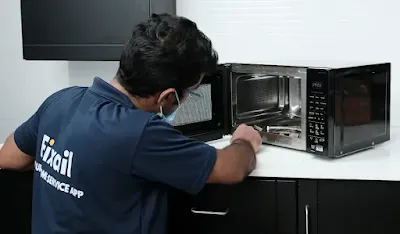What Can Cause My Microwave’s Light to Stop Working?
What Can Cause My Microwave’s Light to Stop Working?
A microwave’s internal light is a small part that does an important job—it helps you watch your food while it heats. So, when that light goes out unexpectedly, you might wonder if it’s a simple problem or a sign of something worse. If you’re looking for a microwave oven repair shop nearby, knowing the possible reasons for the light not working can help you figure out the issue or clearly explain it to a repair person.
Let’s look at the most common reasons why your microwave light might not work and what you can do about it.
Why the Microwave Light is Important
While the internal light doesn’t change how well your microwave heats, it adds to safety and ease of use. It helps you see if food is overflowing or if metal items were accidentally left inside, without opening the door. A light that doesn’t work may not be a big emergency, but it’s definitely something you’ll want to fix.
1. Burnt-Out Light Bulb
The easiest reason your microwave light isn’t working is that the bulb has burned out.
Solution:
- Look in your microwave’s user manual for the type and location of the bulb.
- If you can reach it, unplug the microwave and replace the bulb with a new one of the same type.
- If it’s a built-in model or you can’t find the bulb, getting professional help is advised.
⚠️ Caution: Microwaves can hold high-voltage energy. If you’re unsure, avoid doing it yourself and visit a microwave oven repair shop nearby for safe replacement.
2. Faulty Door Switch
Microwaves have safety switches that manage things like heating and lighting. If the door switch is broken or misaligned, the microwave may think the door is open and turn off the light.
Signs:
- The light doesn’t turn on even when the door is open.
- The microwave doesn’t start or stops partway.
Solution:
- A broken door switch should be checked and replaced by a skilled technician to avoid dangers.
3. Wiring or Circuit Problems
If your light bulb is good but it still doesn’t work, the problem might be with internal wiring or a burned-out part of the circuit board. This is especially possible if other parts of the microwave are also acting up.
Solution:
These are complicated electrical fixes that need special tools and expertise. Searching for a microwave oven repair shop nearby is your best option for an accurate diagnosis.
4. Control Panel or Board Problem
Some microwaves control the light through the main control board. If this board has a problem, the light circuit might stop working even if the bulb is fine.
Symptoms:
- Other features like the timer or buttons, may also act strangely.
- The light flickers or doesn’t turn off even when the door is closed.
Solution:
A faulty control board is best checked and replaced by a trained technician. Trying to repair it yourself can be dangerous.
When to Get Professional Help
While changing a bulb might be easy for some people, most light problems in microwaves involve internal parts that can be risky to touch. If you’re not sure about doing electrical repairs—or if the issue isn’t just a bulb—it’s best to ask for professional help.
Finding a trusted microwave oven repair shop nearby can help you avoid wasting time, reduce stress, and prevent possible injury.
Conclusion
When your microwave’s light goes out, it may seem like a small problem, but it can indicate more serious issues that shouldn’t be overlooked. Whether it’s just a bulb change or a more complicated internal problem, getting the right assistance is crucial. That’s where Fixail comes in. With skilled technicians and dependable service, Fixail provides professional microwave oven repairs at your convenience.
From finding electrical problems to safely changing broken parts, Fixail makes sure your microwave works well—and your kitchen stays bright and safe. If you need reliable and efficient service nearby, you can trust Fixail.




Comments
Post a Comment